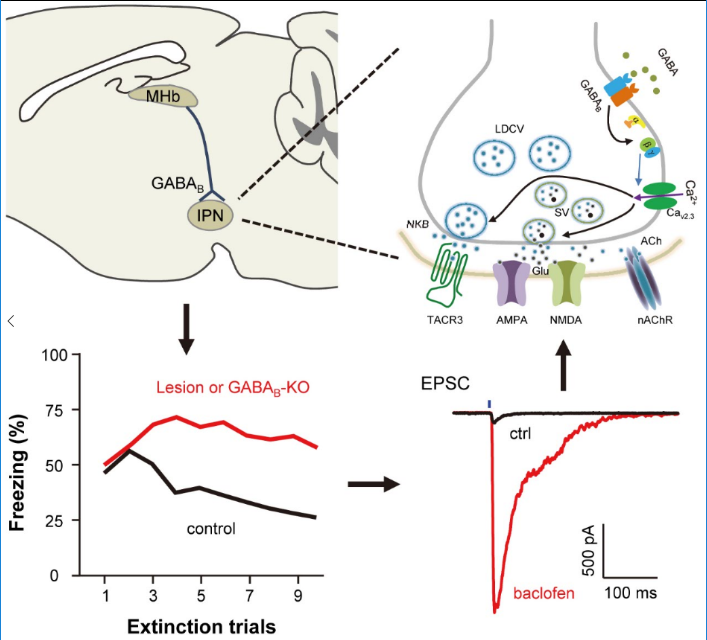Research News
Studies from Dr. Minmin Luo’s lab revealed a new neural circuit that regulates fear memory expression through surprising cellular mechanisms
On July 14, 2016. Dr. Minmin Luo's lab published a research article entitled "Presynaptic Excitation via GABAB Receptors in Habenula Cholinergic Neurons Regulates Fear Memory Expression"in the journal Cell.

When an environmental cue predicts threat, we respond with fear. When that cue ceases to predict threat, our fear response gradually extinguishes. Excessive fear or fear that persists in the absence of threat is dysfunctional as in phobias and post-traumatic stress disorder. Studies so far have focused on the roles of the extended amygdala and its connected brain areas in fear behaviors. Here, the authors report that the habenulo-interpeduncular pathway, a neural circuit outside of the amygdala, regulates fear memory expression and extinction through a surprising cellular mechanism. The authors found that killing cholinergic neurons in the medial habenula or inactivating their GABAB receptors causes prolonged fear response even when a cue no longer predicts danger, whereas activating the cells or their GABAB receptors suppresses fear responses. These findings lead the authors to conclude that the habenulo-interpeduncular pathway, which is evolutionarily conserved in all vertebrates, plays a crucial role in regulating fear responses.
The authors further discovered that, in contrast to the traditional view that GABAB receptors are exclusively inhibitory, GABAB receptors in the habenula cholinergic neurons mediates their behavioral effect by strongly enhancing the corelease of multiple neurotransmitters, including glutamate, acetylcholine, and neurokinin B. Another twist in the tale: although GABAB receptors often close calcium channels, the receptors here excite the cells by facilitating the opening of a peculiar R -type calcium channels. Based on the newly identified mechanisms, the authors identified several compounds, including a PDE2A inhibitor, that activate the neural pathway and speed up the extinction of fear memory. These findings thus substantially expand our understanding of the signaling capacity of GABA and GABAB receptors. Moreover, it suggests alternative therapeutic approaches to treating fear disorders.
Graduate students Juen Zhang, jointly trained by the National Institutes of Biological Sciences (NIBS), Beijing and Tsinghua University, is the first author of this article. Lubin Tan from Minmin Luo’s lab is the co-first author. Other contributors include Yuqi Ren, Jingwen Liang, Rui Lin, Qiru Feng, Jingfeng Zhou, Fei Hu, Jing Ren, Chao Wei, Tao Yu, Yinghua Zhuang, and Fengchao Wang from NIBS, Beijing as well as Bernhard Bettler from University of Basel. Dr. Minmin Luo is the corresponding author. This research was supported by the Chinese Ministry of Science and Technology 973 Grants and the Beijing Municipal Government, and was conducted at the National Institute of Biological Sciences, Beijing.



